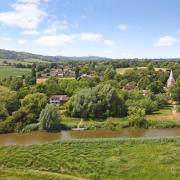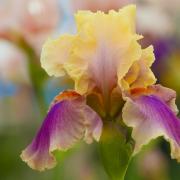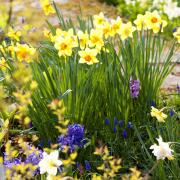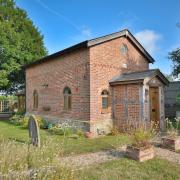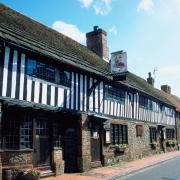Visiting our gardening heritage at places such as The Weald and Downland Living Museum can guide us today by rediscovering techniques and plant knowledge from generations that have gone before
We have some wonderful, grand estates in Sussex to inspire but it’s also really helpful to see gardens on a more attainable scale. Historic gardens have been created around the buildings of The Weald and Downland Living Museum near Chichester to add an additional layer of information for visitors to learn about how people lived and supported themselves in their homes.
Food was naturally the priority, along with growing plants for medicinal and practical uses, such as strewing herbs on the dirt floors to help keep pests away while releasing pleasant aromas.

Using the land efficiently was integral to survival. Walking through the seven historic gardens of everyday people there gives a unique opportunity to learn how gardens evolved from purely utilitarian and functional to being more aesthetic, the knowledge passed down through generations orally. It also shows how our ancestors relied on what they could grow on their small plots to sustain themselves throughout the year.
By setting each garden in the same period and social status as the house it is attached to you can see the gradual transition from the early 15th century at Bayleaf Farmhouse to the late 19th century at Whittaker’s Cottages with not only planting for practical use but also the introduction of decorative herbaceous borders in worker’s gardens.
‘People these days are thinking both financially and environmentally, and we can learn lessons from the past, from the ways in which we garden, gaining knowledge of what is edible, connecting with the environment, to the importance of biodiversity to attract beneficial predators,’ explains Carlotta Holt, the museum gardener.

As you wander the gardens take note of the array of plants grown, many of which are labelled with the date introduced and uses. You are bound to discover ones that you didn’t even know were edible or useful. The helpful staff and volunteers, along with information boards and demonstrations, will guide your knowledge of the plants and their many uses.
‘Education through interaction with the visitors is so beneficial,’ says Carlotta. ‘People were really connected with the time of the year and with their environment.’ Herbs and wild flowers were essential: cowslips could be made into tisanes for headaches, for example, meadow sweet-flavoured mead and woad a natural dye. Plants we think of as weeds were also utilised – you may know about the culinary uses of nettles such as making pottage, but did you know the fibres made string and fibres for linen, young leaves of ground elder were eaten both raw and cooked, or that soapwort makes a natural lather for cleaning? Self-sufficiency through multiple uses of plants was essential for survival so identification of the plants was key.
All the produce and plants grown at the museum are used as they would have been by our ancestors, honed over time through trial and error, making this a valuable resource for us today. Meticulous research and sourcing has built up a palette of heritage plants we could be using in our own gardens.

To incorporate some heirloom or heritage varieties of fruit and vegetables at home, the principles are the same, apart from they’re being open pollinated so you need to consider where to plant them, together with others or isolated. This really depends on whether the plant is self-fertile or requires pollination by wind or insect.
To preserve the quality of an heirloom it is advised to plant one variety of species at a time to prevent cross-over. This can involve growing apart from other plants, such as in screened cages, or hand pollinating individual flowers of the most productive and tasty plants.
Allow seeds to ripen before harvesting, bring inside, dry, label and store. They will keep three to five years. Some crops work well grown together as they can offer beneficial factors, such as garlic and onions repelling carrot fly. Other crops are suggested to not be planted together as they compete or require quite different growing conditions.
You will also see at the museum the use of companion plants, such as self-seeding marigolds, to bring in beneficial predators. Companion planting is used to benefit plants both to protect and also to increase productivity. Polyculture, rather than monoculture has been shown to be good for the soil and for the plants themselves. ‘Utilitarian and functional can also be pretty and functional,’ says Carlotta. ‘Have a diverse range of plants, crops, herbs, and flowers. Keeping bees would also have been important for pollination, wax for candles and the honey.’

TO KNOW
• The Weald and Downland Museum, Chichester, PO18 0EU
Many heritage seeds are available in the gift shop
See website for details and special events
www.wealddown.co.uk
• The Heritage Seed Library, www.gardenorganic.org.uk
GET THE LOOK

• Edible and ornamental plants grown for their uses to maximise production while working with nature
• Heirloom or heritage vegetables are open-pollinated, the seeds have been passed down from generation to generation
• Open pollinated means the variety breeds true from seed, growing offspring with the same characteristics
• It’s taste that most people cite for the reason they choose to grow heirloom varieties, along with the individuality
• Before manufactured medicines people relied on the healing properties of roots, trees and plants
• Complementary benefits for minor ailments or to improve general wellbeing can be grown safely in your own garden
• There are different extraction methods for fresh and dried plant parts of plants and numerous ways to prepare herbal medicine, such as infusions in water, oil, creams, alcohol tinctures and juices
• People don’t realise what we have in our native herbs, ones we can pick and eat just as our forefathers did, such as primroses, ground ivy, lungwort or marsh mallow which was eaten like potato or added to make stock thicker and is good for sore throats
• You can grow plants for infusions easily, from hawthorn to rosemary
• Herbs are the foundation of all our medicines, don’t think they are mild, if you are taking manufactured medicines they can react, so always be cautious and don’t drink them every day
TOP TIPS FROM CARLOTTA

• It is important to keep heritage varieties of crops growing
• Think where your crops/seeds are coming from
• Collect your own seeds and allow some things to self-seed
• Grow organically
• It’s all about the soil, enrich with waste crops, manure, mulch
• Minimize digging to stop nutrients leaching
• Connect with your environment
• Knowledge is key, for example herbs can be powerful so research is important






